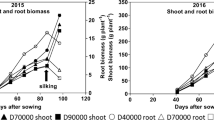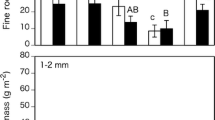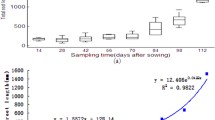Abstract
The architecture of the root system is related to its water and mineral uptake. In this paper, the number, growth, and branching of first-order lateral roots are studied on field grown maize (early maturing cultivar ‘Dea’), mainly in relation to the depth and to the rank of the bearing phytomer. The soil was a deep clay loam, without any barrier until 1.80 m.
The branching density was studied along axile roots until 1.40 m from the base, on a sample of individually excavated axile roots. A strong gradient of density was shown: the mean branching density decreased from 12 roots.cm−1 near the base to 4 roots.cm−1 at a 60 cm depth. Seminal roots were less densely branched than nodal roots. The mean difference was about 4 roots.cm−1.
The length and branching density of lateral roots were studied on mature parts of the root systems where the growth and branching of the laterals were completed, using samples extracted from large soil monoliths. The length distribution of lateral roots was highly asymmetrical, for every source phytomer (mean: 25 mm; median: 16 mm). Many lateral roots were very short, and only 2 % reached a length higher than 10 cm. Only 29 % of all the laterals bore second-order lateral roots. Vigorous laterals branched more systematically and more profusely: the branching density varied from 2 to 5 roots.cm−1 according to the length of the mother lateral root. Both the number and length of lateral roots appeared to be affected by the soil bulk density which varied with the depth.
Similar content being viewed by others
References
Becker R A, Chambers J M and Wilks A R 1988 The New S Language. A Programming Environment for Data Analysis and Graphics. Wadsworth & Brooks/Cole, Pacific Grove, California, USA. 702 p.
Cahn M D, Zobel R W and Bouldin D R 1989 Relationship between root elongation rate and diameter and duration of growth of lateral roots of maize. Plant and Soil 119, 271–279.
Clarkson D T 1991 Root structure and sites of ion uptake. In Plant Roots, the Hidden Half. Eds. YWasiel, AEshel and UKafkafi. pp 417–454. Marcel Dekker, Inc. New-York, Basel, Hong-Kong.
Coutts M P 1987 Developmental processes in tree root systems. Can. J. For. Res. 17, 761–767.
Feldmann L J 1979 The proximal meristem in the root apex of Zea mays. Ann. Bot. 43, 110.
Fitter A H 1991 Characteristics and functions of root systems. In Plant Roots, the Hidden Half. Eds. YWaisel, AEshel and U Kafkafi. pp 3–24. Marcel Dekker, Inc. New-York, Basel, Hong-Kong.
Fusseder A 1987 The longevity and activity of the primary root of maize. Plant and Soil 101, 257–265.
Gladish D K and Rost T L 1993 The effects of temperature on primary root growth dynamics and lateral root distribution in Garden Pea (Pisum sativum L, cv. ‘Alaska’). Environ. Exp. Bot. 33, 243–258.
Granato T C and Raper C D 1989 Proliferation of maize (Zea mays L.) roots in response to localized supply of nitrate. J. Exp. Bot. 40, 263–275.
Habib R, Pagès L, Jordan M O, Simonneau T and Sébillote M 1991 Approche à l'échelle du système racinaire de l'absorption hydro-minérale. Conséquences en matière de modélisation de l'absorption racinaire. Agronomie 11, 623–643.
Iijima M, Kono Y, Yamauchi A and Pardales J R 1991 Effects of soil compaction on the development of rice and maize root systems. Environ. Exp. Bot. 31, 333–342.
Iijima M and Kono Y 1991 Inter specific differences of the root system structures of four cereal species as affected by soil compaction. Jpn. J. Crop Sci. 60, 130–138.
Jordan M O 1992 Les rhizotrons peuvent-ils être utilisés pour l'étude de la ramification des racines primaires nodales du maïs (Zea mays L.)? Agronomie 12, 314.
Jordan M O, Picard D and Trendel R 1992 Ramification des racines nodales primaires du maïs (Zea mays L.). Données de structure et de cinétique. Agronomie 12, 15–30.
Jordan M O, Harada J, Bruchou C and Yamazaki K 1993 Maize nodal root ramification: Absence of dormant primordia, root classification using histological parameters and consequences on sap conduction. Plant and Soil 153, 125–143.
MacLeod R D 1990 Lateral root primordium inception in Zea mays L. Environ. Exp. Bot. 30, 225–234.
McCully M E and Canny M J 1988 Pathways and processes of water and nutrient movement in roots. Plant and Soil 111, 159–170.
McCully M E and Mallet J E 1993 The branch roots of Zea. 3. Vascular connections and bridges for nutrient recycling. Ann. Bot. 71, 327–341.
McMichael B L and Quisenberry J E 1993 The impact of the soil environment on the growth of root systems. Environ. Exp. Bot. 33, 53–61.
Morita S, Thongpae S, Abe J, Nakamoto T and Yamazaki K 1992 Root branching in maize. I. “Branching index” and methods for measuring root length. Jpn. J. Crop Sci. 61, 101–106.
Pagès L, Jordan M O and Picard D 1989 A simulation model of the three-dimensional architecture of the maize root system. Plant and Soil 119, 147–154.
Pagès L, Kervella J and Chadoeuf J 1993 Development of the root system of young peach trees (Prunus persica L. Batsch): a morphometrical analysis. Ann. Bot. 71, 369–375.
Pellerin S and Pagès L 1994 Evaluation of parameters describing the root system architecture of field grown maize plants (Zea mays L.). I. Elongation of seminal and nodal roots and extension of their branched zone. Plant and Soil 164, 155–167.
Peterson C A, Murrmann M and Steudle E 1993 Location of the major barriers to water and ion movement in young roots of Zea mays L. Planta 190, 127–136.
Varney G T, Canny M J, Wang X L and McCully M E 1991 The branch roots of Zea. I. First order branches, their number, sizes and division into classes. Ann. Bot. 67, 357–364.
Varney G T and McCully M E 1991 The branch roots of Zea. II. Developmental loss of the apical meristem in field-grown roots. New Phytol. 118, 535–546.
Waisel Y and Eshel A 1991 Multiform behaviour of various constituents of one root system. In Plant Roots, the Hidden Half. Eds. YWaisel, AEshel and UKafkafi. pp 39–52. Marcel Dekker, Inc. New-York, Basel, Hong-Kong.
Author information
Authors and Affiliations
Rights and permissions
About this article
Cite this article
Pagès, L., Pellerin, S. Evaluation of parameters describing the root system architecture of field grown maize plants (Zea mays L.). Plant Soil 164, 169–176 (1994). https://doi.org/10.1007/BF00010068
Received:
Accepted:
Issue Date:
DOI: https://doi.org/10.1007/BF00010068




